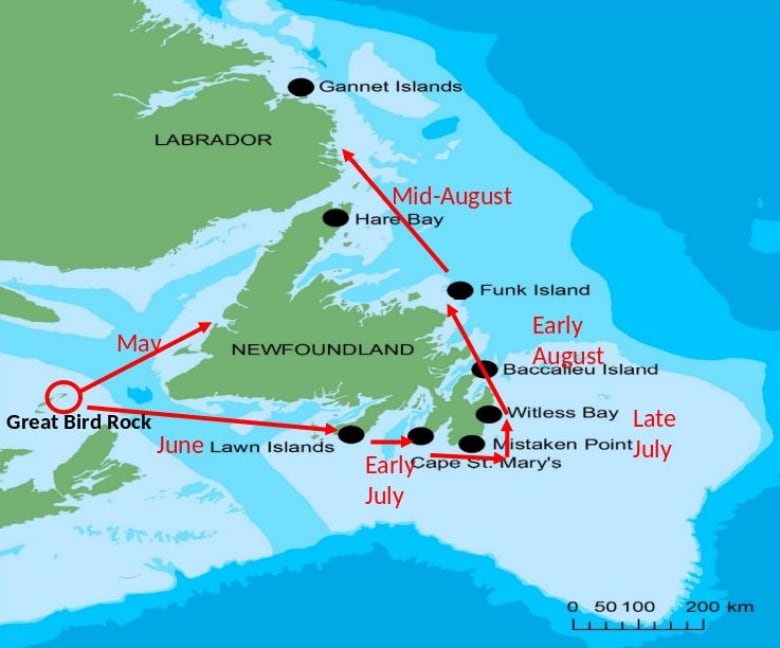Avian flu is devastating seabird colonies across North Atlantic ocean | CBC Radio
In this article, Bill Montevecchi writes how the avian flu is killing off seabird colonies in Newfoundland and beyond — and warns something needs to be done.
Where did avian flu come from?
Avian Influenza (HPAI H5Nx) variants were first detected in 1996 among domestic fowl in Asia. The influenza then radiated in poultry through Russia to Europe, Africa, and North America.
Since 2005, multiple outbreaks in Europe have infected wild waterfowl. These ducks and geese transmit Low Pathogenic Avian Influenza (LPAI) throughout their wild populations with no signs of infection.
When they interact with domestic fowl, however, it can lead to viral transmission between and among domestic and wild birds. The low pathogenic strains can then evolve into Highly Pathogenic Avian Influenza (HPAI) viruses that can induce mass mortality.
By 2014, a highly infectious variant of Avian Influenza (HPAI H5N1) appeared to be endemic in domestic fowl populations in Africa and Eurasia. Outbreaks in western Canada were thought to have been transmitted from Russia via the Aleutian archipelago.
In late November 2021, HPAI H5N1 was detected in Newfoundland. An infected goose or duck that crossed the North Atlantic may been carrier. In December 2021, hundreds of domestic fowl died at an exhibition farm in eastern Newfoundland and the virus was discovered in a wild great black-backed gull.
The spread of the avian flu
In May 2022, dead gannets began showing up on the west coast of Newfoundland. They were likely from Gulf of St. Lawrence on the large colony in the Magdalen Islands where hundreds of gannets were dying.
Reports of sick, dying and dead seabirds were soon coming in from the south coast of Newfoundland. In late June, fishermen reported dead gannets off the cliffs of Cape St Mary’s, at the large and spectacular gannet colony, and a sub-adult bird tested positive for HPAI H5N1.
This was the virus’s closest approach to a gannet colony in Newfoundland. The fuse was lit.
Gannets can breed for 20 years or more, but do not begin breeding until about five years of age. Hence, large numbers of young pre-breeding birds are in the population. These sub-adults are not tied to a specific nest-site and move among colonies. They could act as vectors carrying the virus from colony to colony.

On June 2, 2022, 15 breeding gannets in the Cape St. Mary’s colony tested negative for the virus. Yet two weeks later, 10 of 13 gannet carcasses on a nearby beached tested positive. The colony had been hit.
Sick, dying and dead birds left a trail of coastal carnage as the virus continued its trajectory eastward passing the massive seabird colonies in Witless Bay and on Baccalieu and Funk Islands.
Preliminary assessments indicate that tens of thousands of seabirds have succumbed to the virus in Newfoundland.
For gannets the situation is especially dire, as they were severely impacted at colonies throughout their entire North Atlantic range from Europe, through Scandinavia and Iceland as well as in Quebec and Newfoundland.

What to expect
It is unlikely that the virus will go away, and as bird congregate at colonies, there is risk of contagion and of viral modification into more virulent strains. Ocean climate change could likely play a role.
For instance, while the first infections at Cape St. Mary’s were detected by fishermen in late June, the viral expression, mass mortality and colony abandonment occurred more than a month later.
In August, the ocean water heated rapidly to 16 degrees, which exceeds the thermal tolerance of the gannets’ preferred prey — Atlantic mackerel.
The mackerel likely moved to cooler water below and beyond the range of parental gannets trying to obtain food
for their chicks. This stress could have been a tipping point that triggered the mass mortality.
Ocean warming is predicted to increase, and if the virus remains virulent, the combination of the two could wreak further devastation for seabirds worldwide.
What can be done?
Precautionary approaches are essential. In 2023, biologists will monitor seabird colonies to assess immediate population effects. Things may not appear too different however, if young inexperienced birds infiltrate the nest-sites vacated by older breeders that died.
The feeding aquatic birds must stop, because the likelihood of viral transmission via aerosol, saliva and feces increases when they congregate. Though there appears to be little risk of viral transmission to humans, the possibility remains and the recent death of a young girl in Cambodia strikes a warning that cannot be ignored.

Do not handle sick, dying and dead birds, rather report them to wildlife authorities and rescue groups. They will collect the birds and assay them for infection. Reporting compromised and dead birds is essential, as the information is otherwise unavailable to researchers. Public reports formed the basis for mapping the geographic and temporal trajectories of the virus.
On local and global scales, biosecurity targets both poultry producers and seabird researchers. Some commonalities include preventing the interactions of domestic and wild birds, wearing protective gear, and using disinfectants after avian exposure. Individual as well as corporate and organizational efforts are needed to guard against the spread of the virus.
Transparent information flow is the primary vector and for understanding the Avian Influenza and its many ramifications as we continue to adapt to environmental change.
*Written by Bill Montevecchi. **This episode of IDEAS was produced by Mary Lynk. She followed biologist Bill Montevecchi to Cape St. Mary’s and also Bay De Verde, where they conducted an overnight experiment and rescue mission of young storm petrels leaving their nest for the first time along Newfoundland’s coastline.
Ideas54:00The Bird Man: Adventures with Bill Montevecchi
For all the latest Technology News Click Here

